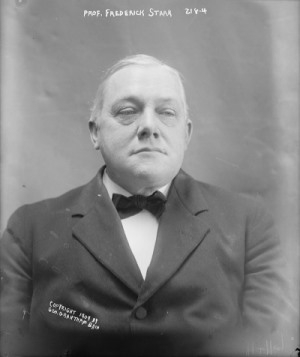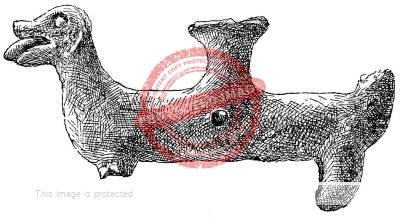Frederick Starr (1858-1933), born in Auburn, New York, was a distinguished American anthropologist who visited Lake Chapala over the winter of 1895-1896.
Starr, whose primary scientific background was in geology, graduated from Lafayette College in 1882 and was appointed as a biology professor at Coe College.
In 1889, as his academic interests shifted towards ethnology and anthropology, he accepted a post at the American Museum of Natural History. A few years later he was asked to organize anthropological teaching at the University of Chicago. Starr was Associate Professor of Anthropology at the University of Chicago from 1892 until 1923, a decade before his death in Tokyo, Japan, on August 14, 1933.
A passionate anthropologist, with a particular enthusiasm for fieldwork, his research on several continents led to such diverse works as The Truth about the Congo (1907), In Indian Mexico, A narrative of Travel and Labor (1908) and Japanese proverbs and pictures (1910).

Frederick Starr in 1909.
In Indian Mexico has extensive descriptions of Lake Pátzcuaro, Uruapan, Zamora and many smaller villages. A contemporary reviewer described this book as: “the work of a keen observer, whose description of the picturesque customs of the Mexican Indians has a deeper significance than a mere collection of interesting details. Combining the qualities of the trained ethnologist with a rare sense of the picturesque, he has given us an altogether admirable book.” American novelist Charles Embree (who wrote a novel set at Lake Chapala) wrote an appendix to In Indian Mexico.
Prior to In Indian Mexico, it had been assumed that traditional methods of making paper from tree bark were extinct in Mexico. Starr, however, discovered that the ancient craft was still practiced (as it is even today) in the Otomi village of San Pablito in the state of Hidalgo.
Prior to Starr’s three-month visit to Guadalajara and Lake Chapala over the winter of 1895-1896, he was quoted in The Salt Lake Herald as saying:
“I will first go to Guadalajara to study a submerged city in Lake Chapala, and ‘Mountain Idiots’ inhabiting the mountains nearby. This is a race of dwarfs which has been studied very little and my intention is to try to determine whether these people are racially small or have become so by disease. I will have the assistance of Archbishop Gillow, an authority on the dwarf races. In the interior of Guatemala the pigmies are said to live in caves and holes in the ground and speak languages not known to white men.”
This quote throws up various interesting sidebars. Rumors of a submerged city in Lake Chapala had been circulating for a while in the U.S., presumably mainly on the evidence of the large amount of pottery fragments recovered from the lake bed whenever the water level fell. Archbishop Gillow is a particularly interesting figure in Mexican history, whose story is told in chapter 22 of my Mexican Kaleidoscope: myths, mysteries and mystique.

“Dog” figurine (10 cm in length) from Lake Chapala. (Drawing by M.K. Seralian)
Following his short visit to Lake Chapala over the winter of 1895-1896. Starr’s research paper, The Little Pottery Objects of Lake Chapala, Mexico described (with illustrations by M. K. Seralian) ollitas and other pottery items found near Jocotepec at the western end of the lake. He collected and studied 261 individual specimens and considered several alternative possibilities before concluding that they are likely to be “offerings made to the lake itself or some spirit resident there-in?”
Starr recognized that changes in lake level might be common and more than sufficient to explain why the pieces were now found at some distance from the current shoreline:
“So far as their presence in the lake is concerned it is possible that the lake’s level may have risen, covering an original place of deposit on the dry land. The spot is almost within sight of the active volcano of Colima, and changes of level, through volcanic or other igneous agency, in the waters of the lake are not improbable. The old schoolmaster at Chapala insists that the town of Chapala has long been slowly sinking, and that half of it has already been engulfed by the lake. He also claims that the god formerly worshipped at Chapala was a little god, a child god, and that the little vessels were offerings to him.”
In December 1895, mid-way through his visit, Starr attended a performance of the Pastores (Shepherds), a Passion Play in Chapala . Starr included a detailed description of this event in an article published the following year in The Journal of American Folklore. Starr considered it to be “probably entirely foreign”, compared to Tastoanes and Conquista festivities which combined Indian and imported elements. According to Starr:
“The play is fairly recent at Chapala. Only a few years ago a young fellow from the village saw it at some other town; he learned it by heart and trained his band of actors. This illustrates the way in which dramas travel – even in Mexico – from town to town.”
Fifty years later, another anthropologist, George Barker, was to witness (and later write about) another unique aspect of Chapala’s Christmas-time celebrations.
This profile is based on an extract from chapter 40 of my Lake Chapala Through the Ages: an anthology of travelers’ tales.
Sources / References:
- The Salt Lake Herald: 16 November 1895.
- Starr Frederick. 1896. “Celebrations in Mexico.” The Journal of American Folklore, Vol 9 #34 (Jul-Sep 1896), pp 161-169.
- Starr, Frederick. 1897. “The Little Pottery Objects of Lake Chapala, Mexico.” Department of Anthropology Bulletin II. University of Chicago Press, Chicago.
- Starr, Frederick. 1908. In Indian Mexico: A Narrative of Travel and Labor. Front Cover · Frederick Starr. Forbes & Company.
Sombrero Books welcomes comments, corrections or additional material related to any of the writers and artists featured in our series of mini-bios. Please use the comments feature at the bottom of individual posts, or email us.
Tony Burton’s books include “Lake Chapala: A Postcard History” (2022), “Foreign Footprints in Ajijic” (2022), “If Walls Could Talk: Chapala’s historic buildings and their former occupants” (2020), (available in translation as “Si Las Paredes Hablaran”), “Mexican Kaleidoscope” (2016), and “Lake Chapala Through the Ages” (2008).
I still pinch myself with ALL the historical and amazing emphermalia and works of art from Ajijc and Syria that I acquired from his nephews estate; my deceased neighbor. The estate was left to the housekeeper and she was throwing out and selling everything because she just inherited a beautiful home. The Litentant COL. followed his Uncles footsteps and moved to Ajijc after the 1967 6 Day War. He and his wife were into the Arts. The pictures, playbills I from their productions are just a small piece of their interesting and fascinating collection. I am so thankful I have been able to preserve their art & history.
Katie, Believe me, we are also most thankful that you preserved these mementos and works of art! Thank you for doing so, and for sharing photos of them for this website, Regards, Tony.